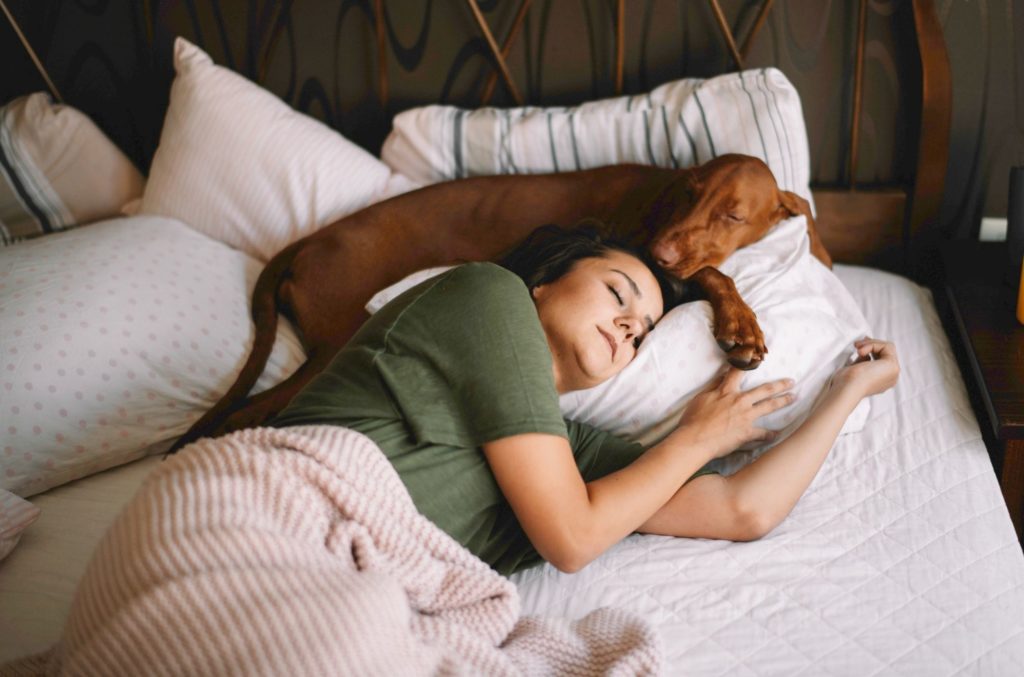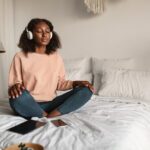If you’re having a hard time sleeping, you’re not alone. A staggering 1 out of 3 adults in the US experience symptoms of insomnia. Since lack of sleep impacts your mental health, including the likelihood you’ll experience anxiety and depression, let’s get straight to the home remedies for insomnia:17 insomnia remedies that focus entirely on habits of mind and behavior.
Each of these 17 insomnia home remedies is simple, affordable, and backed by scientific research. These tips combat some of the common causes of insomnia and are intentionally focused on habits that can be honed throughout your day, not just when you are trying to fall asleep. These suggestions assume you’re sleeping at night and waking in the morning, so please adapt as needed if you are someone who works at night.
If you’re having a hard time sleeping, you’re not alone. A staggering 1 out of 3 adults in the US experience symptoms of insomnia. Since lack of sleep impacts your mental health, including the likelihood you’ll experience anxiety and depression, let’s get straight to the home remedies for insomnia:17 insomnia remedies that focus entirely on habits of mind and behavior.
Each of these 17 insomnia home remedies is simple, affordable, and backed by scientific research. These tips combat some of the common causes of insomnia and are intentionally focused on habits that can be honed throughout your day, not just when you are trying to fall asleep. These suggestions assume you’re sleeping at night and waking in the morning, so please adapt as needed if you are someone who works at night.
1. Make sleep a priority.
While sleep can appear to be a state of “not doing,” the body and the brain are pretty actively performing essential functions in slumber. As renowned sleep scientist, Matt Walker writes, “Human beings are the only species that deliberately deprive themselves of sleep for no apparent gain.”
Although insomnia is a health condition, not a choice, addressing it often requires consistent intention and effort. The best sign of sufficient, quality sleep is waking up refreshed each morning, whether or not you set an alarm.
2. Wake up at the same time each morning.
Though it may seem like a drag, one way to get a handle on sleep is to go to sleep and wake up at the same time each day. If you experienced a sleepless night, sleeping late or taking a long nap can make it even harder to fall asleep at your desired time.
As you likely already know, this can feed a vicious cycle. On the other hand, waking up at the same time anyway can help you get back on track more quickly, so you can get back into your desired sleep cycle.
3. Exercise (but not right before bed)
30 minutes of exercise earlier in the day can improve sleep quality that very same night. Daytime exercise is a great way to encourage balanced circadian rhythms. Exercise elevates the body temperature signaling it’s time to be awake while also releasing endorphins that boost energy.
It helps manage stress throughout the day, which is helpful at night. But don’t exercise right before bed, since this can actually keep you awake longer and, in some cases, may lead to side effects like night sweats.
4. Soak in the sunshine.
Natural light can suppress melatonin and thus reduce daytime drowsiness, setting your rhythms on track from daytime wakefulness and nighttime sleep. While the “home remedy” can be getting outdoors and soaking in the daytime sun, healthcare professionals may recommend “light therapy,” especially if insomnia is related to seasonal affective disorder (SAD) or issues regulating mood in winter. If you can’t make it outside, you can also try opening windows in the morning when you wake up to let some natural light into your sleep space.
5. Nap thoughtfully.
It makes sense. You’re exhausted from not sleeping. Maybe you fear you won’t be able to sleep at night. So the late afternoon crash feels almost inevitable. Unfortunately, long naps further disrupt your sleep-wake cycle, making it harder to get back on track.
A siesta is delightful. If you need one, try to do it earlier in the day and keep it short, ideally 10 – 20 minutes. Interestingly, a coffee nap, where you drink a cup of coffee right before your 20-minute nap, can actually help make you more alert than either a nap or a cup of coffee.
If you really can’t stay awake during the day, talk to a healthcare professional about insomnia since this could be a sign of a health condition.
6. Eat traditionally.
Sometimes lack of sleep nudges us towards sugary foods as a way to manage energy. However, the best way to eat for restful sleep seems to be a diet high in vegetables, whole grains, fruits, and minimally processed protein like beans or lean meat. As some like to say, this means, within reason, sticking to foods that your great-grandma would recognize.
A 2019 study found that diets higher in high glycemic foods (high sugar, starch, and refined grains) lead to a higher incidence of insomnia in postmenopausal women. Another recent study looking at a population of girls aged 12-18 found a diet designed for hypertension, one that’s high in vegetables, fruits, and whole grains, lowered the incidence of insomnia.
7. Challenge negative thoughts.
Patterns of unhelpful negative thinking make us more prone to sleeplessness and make it harder to sleep. One example of this is clock watching. You’re trying to sleep, staring at the clock, with each passing hour, catastrophizing about the terrible day ahead before the sun is even up.
Challenging such thought patterns throughout the day builds the capacity to do the same at night. You might remind yourself, “Even though these thoughts are real, it doesn’t mean they’re the full truth.” In this way, you let your thoughts exist but resist the urge to cling to them as fact. Or perhaps imagery is a better fit for you, imagining your thoughts as leaves on a river, arising and passing away.
8. Set up a cozy sleep space.
Generally, the optimal sleep environment includes a comfortable, quiet, dark space that feels safe and cozy. Ideally, your bed is reserved only for sleep or sex. For some, a relaxing space includes a light weighted blanket and an eye mask that blocks light. Yes, getting cozy is totally a home remedy you can use to combat insomnia.
But cozy is personal. How can you create your sleep space such that when bedtime rolls around, you have everything you need and want to be there?
9. Develop a wind-down routine.
Too many of us, especially when working from home, go straight from work laptop to bed. Or from social scrolling to bed? If the daytime bustle is a green light go, and your desired bedtime speed is red light stop, what can you do in the few hours before bed to reach yellow light slowing down?
For some, this will be mindfulness, doing a puzzle, mindfully cleaning the kitchen, or taking a leisurely walk. For others, this is listening to music or a podcast. What is a wind-down routine you can start that feels both enjoyable and attainable?
10. Put your phone to bed.
Some people literally put their phone to bed at night in a separate room. Research shows that mobile phone use at night is associated with sleeping less. But most of us don’t need a study to show us that staying up to scroll the other night left us exhausted.
11. Buy a worry notebook.
Just as some put their phone to bed, others like having a space to put their worries to bed. If thoughts or ideas keep you from fully resting, keeping a notebook by your bed can be helpful. That urgent task you just remembered can go in your notebook parking lot until morning. This can also help if you’re experiencing anxiety as a result of insomnia.
12. Track your sleep.
Whether you are sticking to home remedies or seeking professional help, a sleep diary can be a goldmine of insight. Track when you go to bed, when you wake up, and how many hours of sleep you are getting within that span. Track how you feel when you wake up.
There are all sorts of patterns worth noticing. Just one example is the pattern of a short sleeper. Perhaps you are one of those individuals who sleeps less than 7 hours but wakes up refreshed.
This is just human variation and no cause for concern. Or perhaps you think you are sleeping enough but find your sleep is far more inconsistent than you guessed. This is helpful information, too, since you might eventually notice patterns. These might include sleep changes that ebb and flow with hormone cycles, or the ways certain events impact your sleep patterns.
13. Sleep efficiently.
Your sleep diary can be a window into your sleep efficiency. Sleep efficiency is simply your hours in slumber, divided by your time spent in bed. Multiply this by 100 to get your sleep efficiency percentage. If you are in bed for 10 hours but only sleeping for 6, your sleep efficiency would be 60%.
Enhancing sleep efficiency means reducing the amount of time you spend in bed not sleeping.
The professional version of this might be “sleep restriction therapy.” For example, if you were to see a therapist, healthcare practitioner, or sleep expert, they might recommend aligning the amount you’re actually sleeping with your time spent in bed. This could involve identifying a temporarily late bedtime or early wake-up time, intentionally restricting sleep, as you get back on track.
14. Be intentional about what you do when not sleeping.
In a recent journal article in World Psychiatry, Andrew Krystal and colleagues wrote: “What the patient does when not falling asleep is also important.”
He continues, “For example, a patient who gets out of bed and eats ice cream or watches a favorite show when not sleeping is providing positive reinforcement for being awake, which is counterproductive. This can be a behavior to target and eliminate during treatment.”
So set your intentions about what you do when you get up because you can’t sleep. Maybe try a guided meditation, some gentle stretching, or some small task that doesn’t excite your nervous system. Best yet, just do something super boring.
15. Let go.
“Relax” is a funny word. It’s easy to understand but can still elude so many of us. This is why it’s no surprise that “relaxation training” exists and that it can be beneficial as a home remedy for insomnia. If you need help letting go, try any of these relaxing exercises.
One effective relaxation technique is progressive muscle relaxation. Here are the basics: Start by lying down comfortably. Moving from head to feet or feet to head, tense one body part at a time for 5 seconds, and then release.
Learn how to relax your body with PMR in this video.
16. Get app-y.
Cognitive behavioral therapy is one of the most effective treatments for insomnia. In fact, the Department of Veteran Affairs created an app called CBTi coach that’s available for free. Here you can keep a sleep diary, learn tools for relaxation, challenge unhelpful negative thoughts, and more.
17. Reach out to a professional.
It’s worth reiterating that sleep issues deserve your attention now. Lack of restful sleep is associated with impaired functioning, reduced concentration, mood disorders, and health outcomes.
If foundational sleep hygiene or behavioral changes aren’t cutting it, reach out to an expert to see if there may be another contributing health issue. You may also want to get in touch with a professional for guidance and accountability or a medication evaluation. Sleep issues, including insomnia disorder, can be health conditions that warrant additional care
Takeaway
- If you’re experiencing insomnia or other sleep disturbances, try adjusting your behavior.
- You can use the natural remedies for insomnia in this article alone or in conjunction with other insomnia treatments.
- If your insomnia doesn’t respond to these behavioral changes or worsens, please connect with a healthcare professional for more info.












